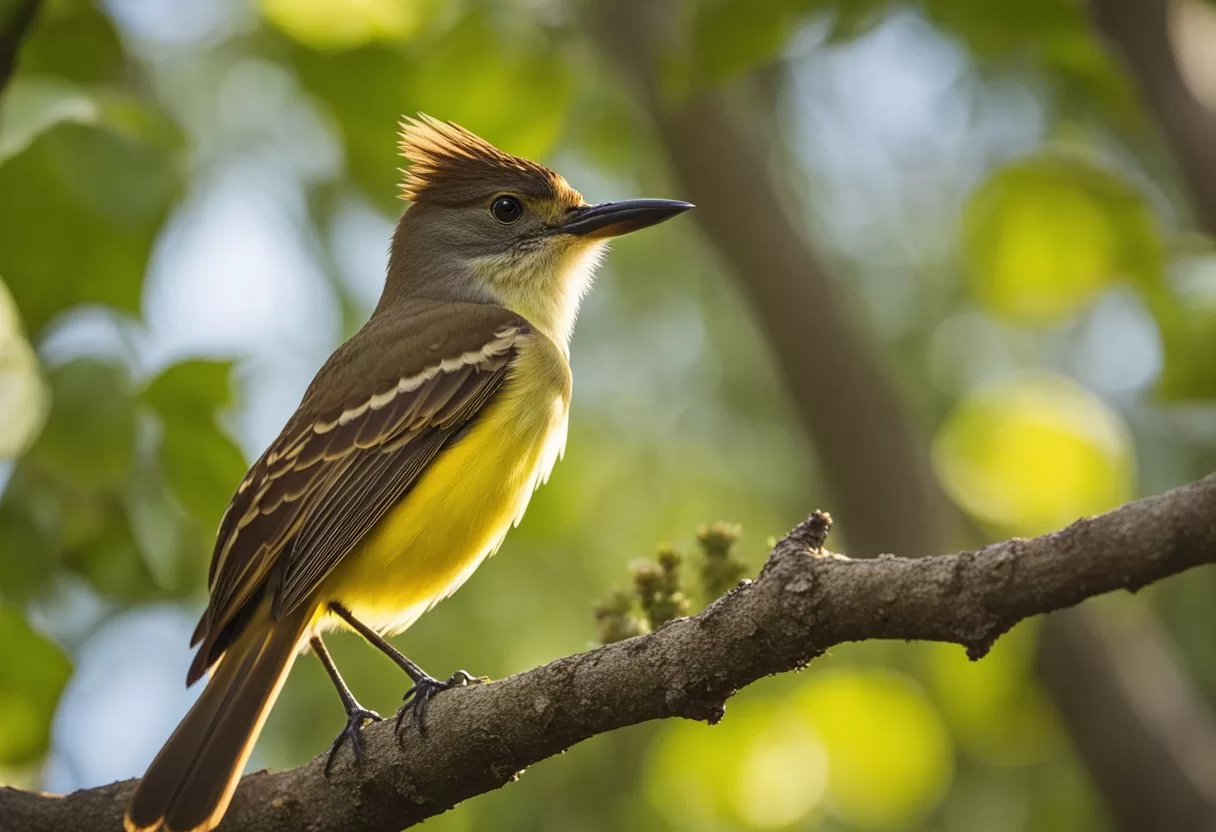Species Overview
You will find the Great Crested Flycatcher, or Myiarchus crinitus, to be a bird species primarily found in Eastern North America, easily identified by its distinctive calls and vibrant plumage.
Taxonomy and Nomenclature
The Great Crested Flycatcher belongs to the genus Myiarchus within the Tyrannidae family. Myiarchus crinitus is its scientific name, indicating its unique characteristics among North American flycatchers. Understanding its taxonomic position helps in recognizing its behavior and role in the ecosystem. The species name “crinitus” refers to its “tufted” or “hairy” appearance, characteristic of these birds.
Physical Characteristics
This bird measures around 6.5–8 inches in length with a wingspan of about 13 inches. It features a bright yellow belly, olive green upperparts, and a rust-colored tail. The crest is not as prominent as suggested by the name but can be raised to signal. Its pronounced features, like a strong beak and loud calls, make it easily identifiable in the wild.
Geographical Range
The Great Crested Flycatcher inhabits a wide geographical range, predominantly in Eastern North America. During the breeding season, they are found from southern Canada to the Gulf of Mexico. They migrate to Central America and the Caribbean during the winter months. Their adaptability to various forest environments makes them a common sight in both rural and some urban areas.
Behavior and Ecology
Great Crested Flycatchers exhibit various behaviors and adaptations that allow them to thrive in diverse ecosystems. Their choices of habitats, food sources, and vocalizations play crucial roles in their daily lives and reproduction.
Habitat Selection
Great Crested Flycatchers favor deciduous forests, open woodlands, and edge habitats. You can often find them in the canopy rather than on the ground. They prefer high perches for better visibility and access to insects. Suburban areas with ample tree cover also attract these birds. Nesting typically occurs in natural cavities or old woodpecker holes. Both sexes participate in selecting and preparing the nesting site, ensuring it provides enough protection and resources for the young.
Feeding Habits
Primarily insectivorous, Great Crested Flycatchers catch insects mid-flight. You might observe them darting from perches to snatch beetles, flies, and caterpillars. Their diet also includes small fruits and berries, which they often feed on during the non-breeding season. When hunting, they prefer the canopy’s foliage, rarely descending to the ground. Their efficient hunting techniques ensure a steady food supply essential for their energy-intensive lifestyle.
Reproductive Behavior
During the breeding season, Great Crested Flycatchers exhibit territorial behavior. Males defend their territory with loud calls while females focus on nesting. They lay around 4-8 eggs, which both parents incubate. Once hatched, nestlings receive care and feeding from both parents. The young fledge in about two weeks, ready to explore their surroundings. Look for nests high in trees, often hidden from predators and harsh weather.
Vocalization Patterns
The call of the Great Crested Flycatcher is a distinct “whee-eep,” easily recognizable and often heard during mating season. These vocalizations help in territory defense and attracting a mate. Alarm calls alert nearby birds of potential threats. Their complex vocal repertoire mainly consists of whistles and sharp notes, enabling them to communicate effectively within their dense habitat.
Conservation and Observation
Ensuring the wellbeing and observing the habits of the Great Crested Flycatcher is critical for bird enthusiasts and conservationists alike. Learn about its conservation status, how to identify it in the field, and tips for successful observation.
Conservation Status
The Great Crested Flycatcher is of least concern according to the International Union for Conservation of Nature (IUCN). This rating means the species is not currently at significant risk. Its population trend is stable, benefiting from a wide range across North America.
Conservation efforts focus on habitat preservation. Wetland and forest areas provide crucial nesting sites. Organizations like the Cornell Lab of Ornithology advocate for protecting these environments to ensure long-term species health.
Urban expansion poses a minor threat, but this adaptable bird often manages to thrive in suburban areas.
Field Identification
Identifying the Great Crested Flycatcher involves observing its distinct physical and behavioral traits. Look for its bright yellow belly, contrasted by an olive-green back. The bird has a bushy crest and a wide bill suitable for catching insects.
Their call is a loud, clear “whee-eep” sound, often heard before the bird is visible. Juveniles and adults exhibit similarities, making age determination challenging.
Use resources from eBird and Birds of the World to familiarize yourself with these identifying marks, as these platforms provide visual aids and sound clips for easier recognition.
Observation Tips
When observing the Great Crested Flycatcher, early morning outings are most effective, as this bird is usually active during dawn hours. Bring binoculars and a field guide to help spot and confirm your sightings.
Stay quiet and patient. This flycatcher often perches high in the canopy, so scan tree branches carefully. Record your sightings on eBird to contribute to citizen science data, helping track population and migration patterns.
Using a bird call app can also attract the flycatcher’s attention, making them easier to spot during your outings.
Share this content:

Post Comment
You must be logged in to post a comment.